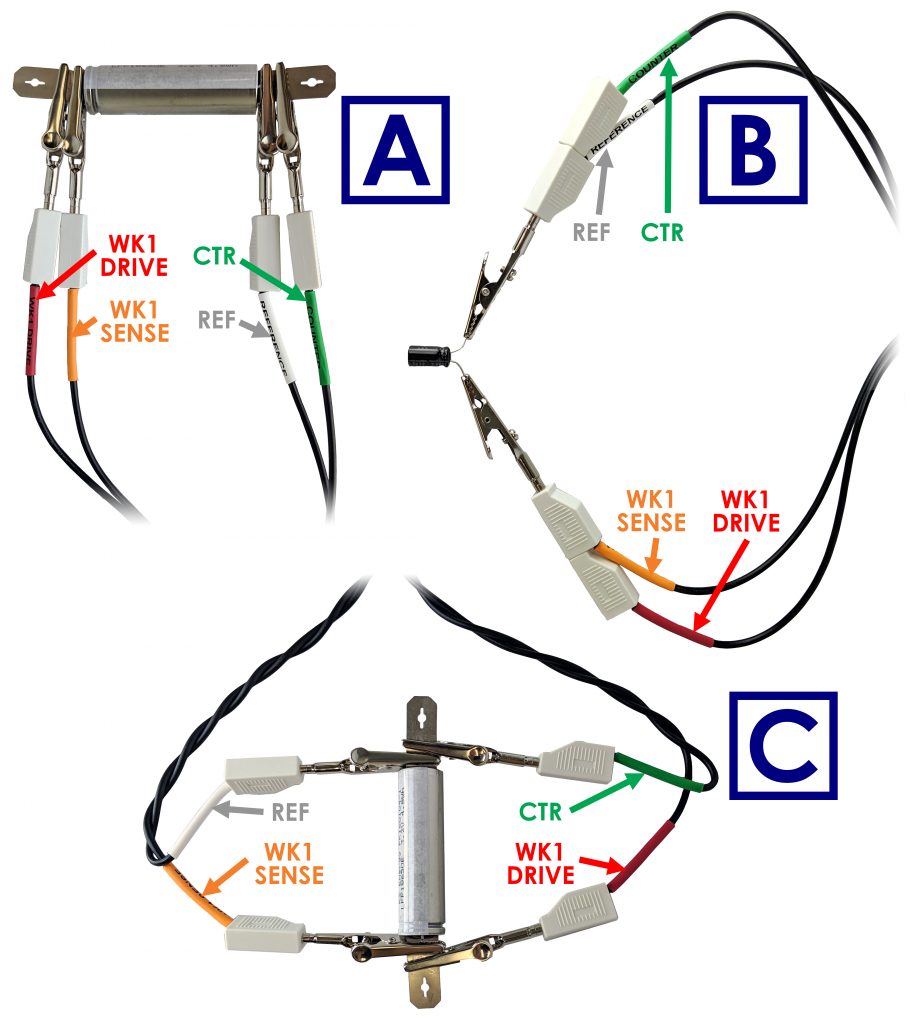Two-Electrode Setups
Last Updated: 5/29/19 by Neil Spinner
1Two-Electrode Setups
Typical examples of two-electrode setups are solid-state experiments that probe electrochemical behavior across a single interface, experiments that involve ion-selective electrodes (where the open circuit potential is measured between an ion-selective electrode and a reference electrode), and rechargeable batteries consisting of an anode and cathode. Simple experiments with common electronic components (resistors, capacitors, and inductors) also use a two-electrode arrangement (see Figure 1 for common two-electrode experimental setups pictured with a WaveDriver cell cable).
 WaveDriver Bipotentiostat Cell Cable
WaveDriver Bipotentiostat Cell Cable

Figure 1. Examples of Two-Electrode Setups (WaveDriver Cell Cable Pictured)
A potentiostat cell cable can be configured for two-electrode experiments in a few different ways depending on the impedance of the system under study. For measured impedances around 1 kΩ, it is acceptable to simply stack together two pairs of banana plugs. The banana plugs for the GREEN (counter electrode) and WHITE (reference electrode) leads are stacked together to form the first pair, and the banana plugs for the RED and ORANGE leads (working electrode drive and sense) are stacked together to form the second pair (see Figure 1B). One pair of shorted leads is connected to one of the electrodes in the system, and the other pair is connected to the opposite electrode. Alternatively, each pair of leads can also be individually clipped to either electrode without stacking the banana plugs if desired (see Figure 1A).
When working with a low impedance load (~10 Ω), cable inductance effects can be minimized by separately twisting the sense lines (ORANGE working sense and WHITE reference) and drive lines (RED working drive and GREEN counter) together (see Figure 1C). The distance between the two sense lines (ORANGE and WHITE) should also be minimized as much as possible, and all connections should be closely spaced and secure to avoid added resistance from long electrode wires or leads. This is also the preferred configuration to use when performing a shorted lead EIS test.
 WaveDriver Shorted Lead EIS Test
WaveDriver Shorted Lead EIS Test
When working with a high impedance load (above ~10 kΩ), cable capacitance effects can be minimized by separating the RED and ORANGE lines from the GREEN and WHITE lines as much as possible (see Figure 1B). This is also the preferred configuration to use during an open lead EIS test.
 WaveDriver Open Lead EIS Test
WaveDriver Open Lead EIS Test
Using the recommended two-electrode polarity convention, the GREEN/WHITE pair should be connected to whichever electrode is considered to be the reference electrode. This convention assures that when the software applies a positive potential to the working electrode, the RED/ORANGE pair is more positive than the GREEN/WHITE “reference” pair. For example, when connecting to a battery or fuel cell, the positive electrode (cathode) should be considered the working electrode and connected to the RED/ORANGE pair while the negative electrode (anode) should be connected to the GREEN/WHITE pair. This will ensure the proper current and voltage conventions are observed when performing charge/discharge or polarization curve experiments.



